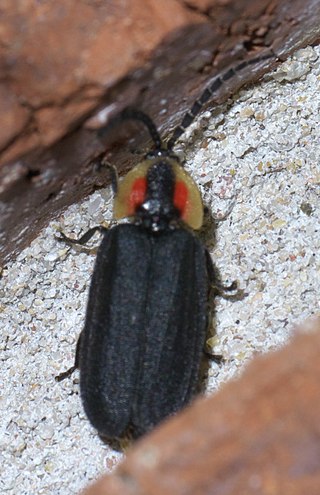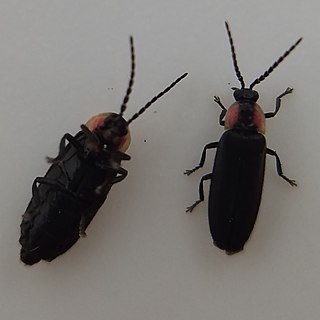
The Lampyridae are a family of elateroid beetles with more than 2,000 described species, many of which are light-emitting. They are soft-bodied beetles commonly called fireflies, lightning bugs, or glowworms for their conspicuous production of light, mainly during twilight, to attract mates. The type species is Lampyris noctiluca: the common glow-worm of Europe. Light production in the Lampyridae is thought to have originated as a warning signal that the larvae were distasteful. This ability to create light was then co-opted as a mating signal and, in a further development, adult female fireflies of the genus Photuris mimic the flash pattern of the Photinus beetle to trap their males as prey.

Photuris is a genus of fireflies. These are the femme fatale lightning bugs of North America. This common name refers to a behavior of the adult females of these predatory beetles; they engage in aggressive mimicry, imitating the light signals of other firefly species' females to attract mates – but Photuris use it to attract, kill and eat the unsuspecting males of those other species. Their flashing bioluminescent signals seem to have evolved independently and eventually adapted to those of their prey, mainly unrelated Lampyrinae, such as Photinus or Pyractomena.
Glowworm or glow-worm is the common name for various groups of insect larvae and adult larviform females that glow through bioluminescence. They include the European common glow-worm and other members of the Lampyridae, but bioluminescence also occurs in the families Elateridae, Phengodidae and Rhagophthalmidae among beetles; as well as members of the genera Arachnocampa, Keroplatus and Orfelia among keroplatid fungus gnats.

Photuris pensylvanica, known by the common names Pennsylvania firefly, lightning bug, dot-dash firefly and glowworm, is a species of firefly from the United States and Canada. It is also widely known under the Latin name Photuris pennsylvanica, although the original spelling, with one "n", was common in Latinized names of the time and remains the valid name.

Photinus pyralis, also known by the common names the common eastern firefly or big dipper firefly, and sometimes called a "lightning bug", is a species of flying beetle. An organ on its abdomen is responsible for its light production. It is the most common species of firefly in North America, and is typically found east of the Rocky Mountains. Photinus fireflies are often confused with fireflies of the similar-sounding genus, Photuris, which are also found in North America.

The rover fireflies (Photinus) are a genus of fireflies. They are the type genus of tribe Photinini in subfamily Lampyrinae. This genus contains, for example, the common eastern firefly, the most common species of firefly in North America.

Photinus carolinus, commonly known as the Smokies synchronous firefly, is a species of rover firefly whose mating displays of synchronous flashing have fascinated both scientists and tourists. As individual females synchronize with males nearby, waves of alternating bright light and darkness seem to travel across the landscape. Firefly displays typically occur in early June near Elkmont, Tennessee, in the Great Smoky Mountains National Park, near Gatlinburg. The species can be found in isolated pockets of the Appalachian Mountains in the eastern United States.
Photuris versicolor, is a species complex of firefly common throughout the Eastern United States. Fireflies famously use flash-based visual signalling to find mates at a distance and each species of firefly has a unique flash pattern sequence that males and females of the same species use to identify one another. Researchers have documented the ability of female P. versicolor to hunt males of other firefly species by mimicking the flash responses of female fireflies of other species. Photuris versicolor appear to target males, such as Photinus pyralis, specifically for the lucibufagin steroids that their prey produce.

Ellychnia corrusca, the winter firefly, is a species of firefly in the genus Ellychnia. It is a lantern-less diurnal beetle common in the United States, Mexico, and Canada. The adults spend winter on a colony tree, favoring Quercus (oak), Carya (hickory), and Liriodendron tulipifera.
Photinus consanguineus, or double cousin firefly, is a species of firefly in the genus Photinus. It is found in eastern North America.
Photinus macdermotti, or Father Mac's firefly or Mr. Mac, is a species of firefly in the family Lampyridae. It is found in North America.
Photinus brimleyi, or sidewinder firefly, is a species of firefly in the Photinus genus. It is found in the southeastern United States.

Lucidota atra, the black firefly or woodland lucy, is a diurnal species of firefly — a member of the Lampyridae family of beetles.
Photinus cookii, or Cook's firefly is a species of day-active firefly in the beetle family Lampyridae. It is found in North America in the Eastern USA, including Florida and Texas.

Photinus consimilis, or cattail flash-train firefly, is a species of firefly in the beetle family Lampyridae. It is found in eastern North America.

Photinus indictus, or silent firefly, is a species of firefly in the beetle family Lampyridae. It is a diurnal firefly, active during the day rather than at night, with no lanterns. It is found in eastern North America.

Pyropyga minuta, or flower elf, is a species of day-active firefly in the beetle family Lampyridae. It is found in Central America and North America.
Photinus tenuicinctus, or thinly-girdled firefly or Ozark spark, is a species of firefly in the beetle family Lampyridae. It is found in the Ozarks in Arkansas and Oklahoma.
Phausis inaccensa, also known as the shadow ghost, is a species of firefly in the family of beetles known as Lampyridae. It is found in central and eastern United States. The larviform females of the species are bioluminescent, whereas the males are winged but lanternless.

Photuris lucicrescens, the long crescendo Photuris, July comet, big scary, or big Lucy, is a species of beetle in the Lampyridae family. It is found in the eastern United States.










